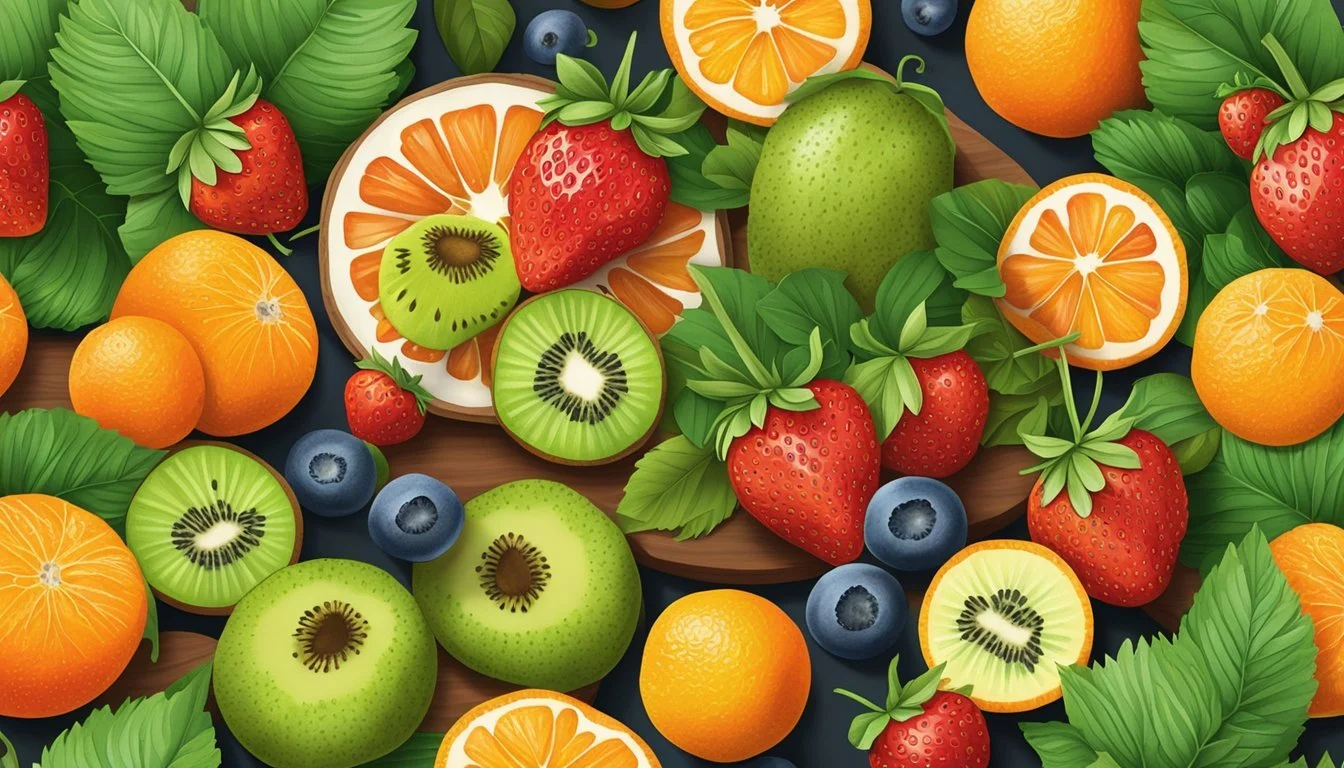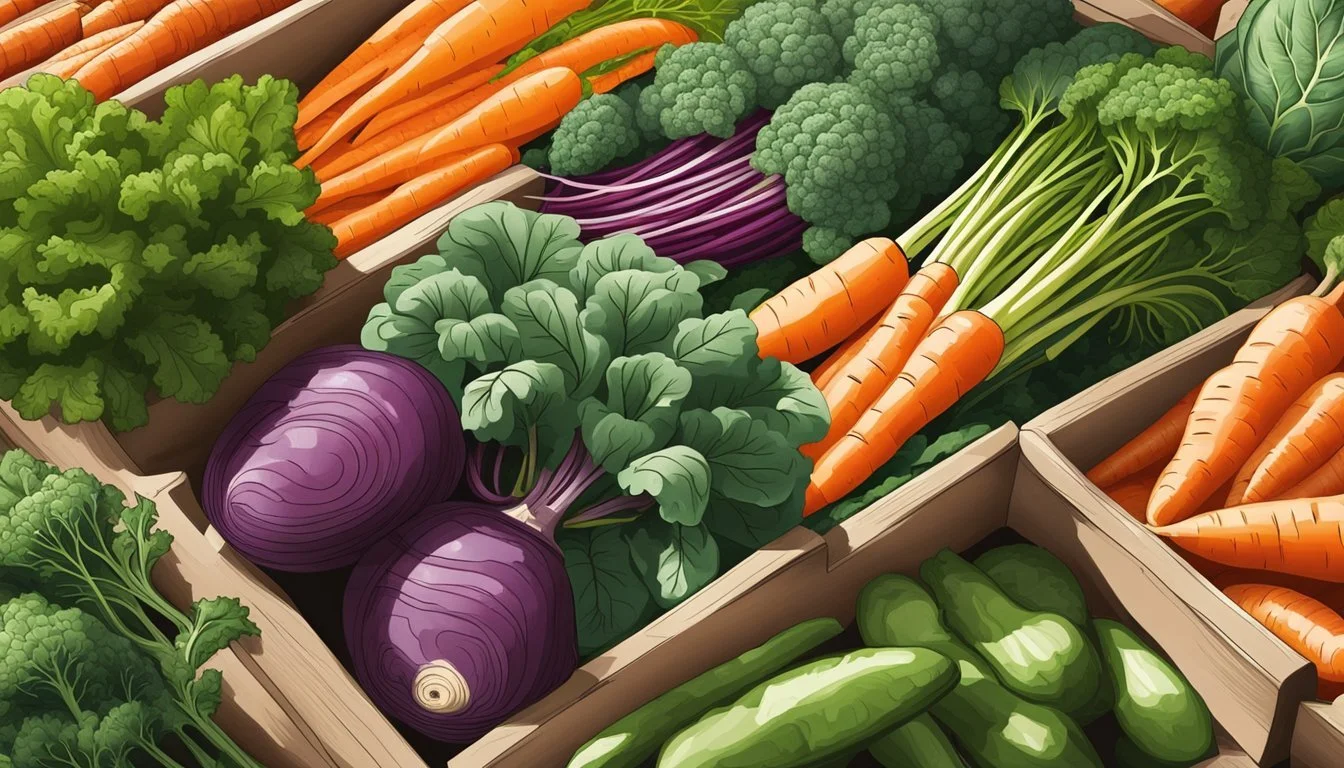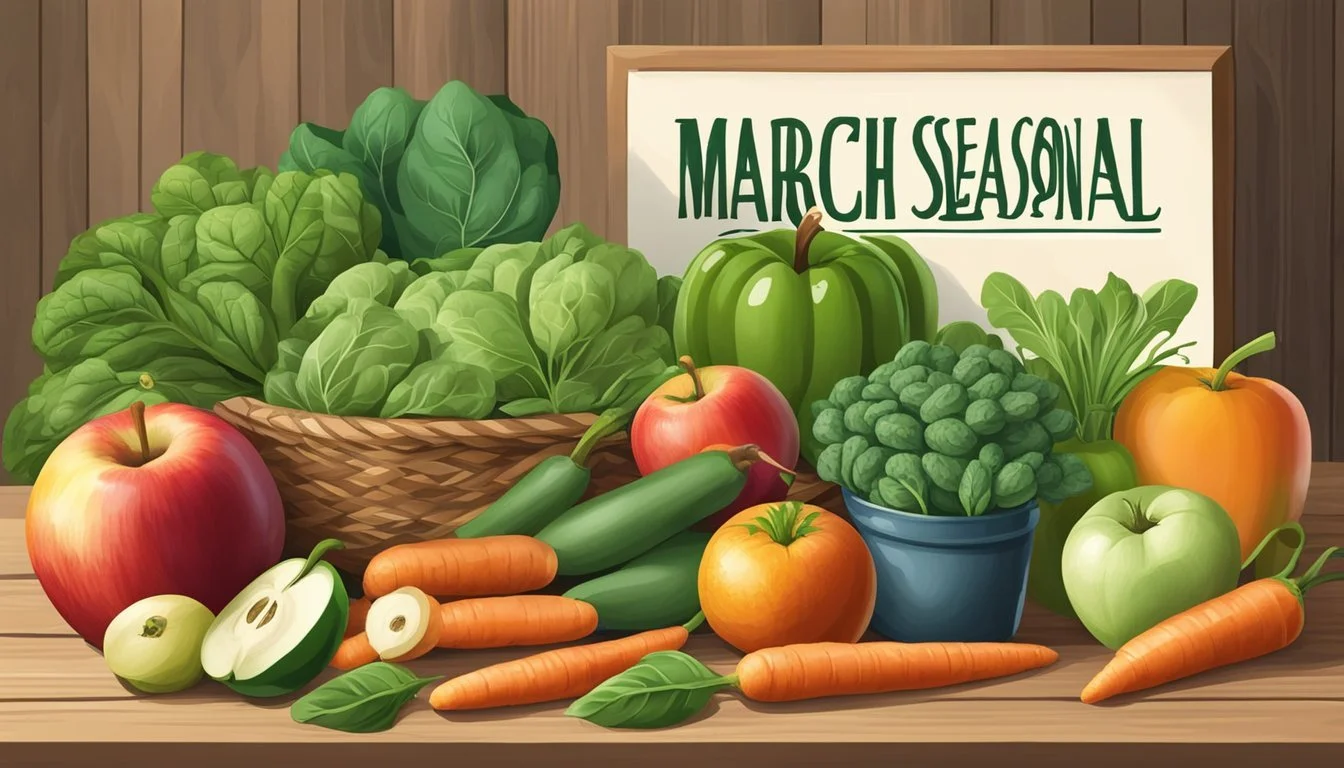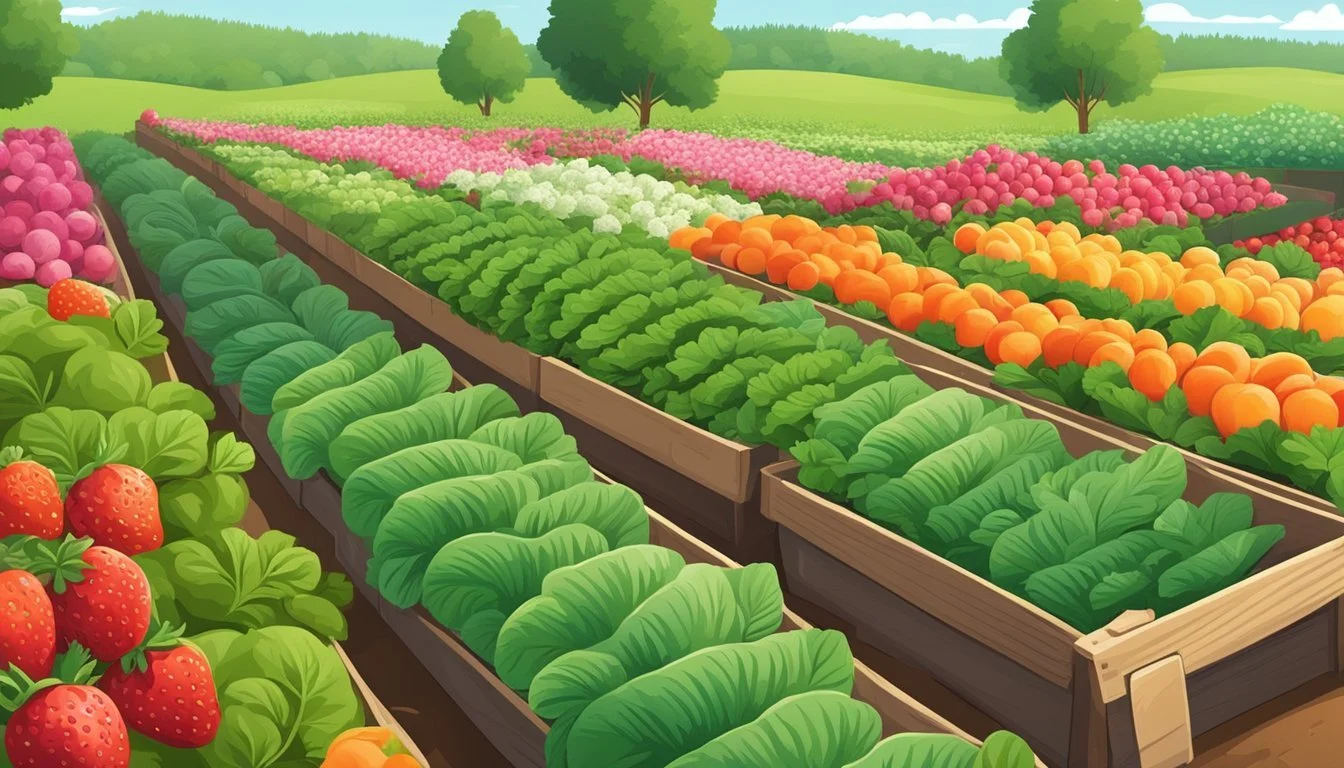Illinois Seasonal Fruit & Vegetables in March
Your Buying Guide
This Article is Part of our Illinois Seasonal Fruit & Veg Calendar
March in Illinois marks a transitional period where the last whispers of winter weather give way to the early inklings of spring’s warmth. During this time, residents and chefs alike turn their attention to the seasonal produce that begins to emerge. The availability of fresh fruits (What wine goes well with fruit?) and vegetables starts to expand, reflecting the gradual shift in the region's growing season. While the selection is not as robust as in the high-summer months, the fruit and vegetable offerings in March provide an ample palette for nutritious and flavorful cooking.
Illinois boasts a range of vegetables that come into season in March. Hardy greens like arugula (how long does arugula last?) begin to peek through the soil, and the storage crops such as beets and Brussels sprouts (how long do brussels sprouts last?) are still in good supply, offering earthy flavors (What wine goes well with earthy flavors?) and vibrant colors to dishes. Root vegetables, a staple during the colder months, are also plentiful during this time, ensuring that soups and stews remain on the menu as hearty options for still-chilly days.
Fruit options during this month may be more limited due to the colder climate, with many summer fruits not yet in harvest. However, Illinoisans often utilize preserved fruits from previous seasons, such as apples stored over winter, to complement the fresh produce on their tables. As the frost recedes and the ground begins to thaw, March stands as a month of culinary transition and anticipation for the greater variety of local produce that spring and summer will soon bring to Illinois.
Seasonal Overview
In March, Illinois begins to experience the transitional phase from the cold embrace of winter to the welcoming warmth of spring. This period marks a significant shift in agricultural productivity as certain crops reach their peak availability.
Significance of March in Illinois Agriculture
March symbolizes a key turning point for farmers and consumers alike in Illinois. The state's agricultural landscape starts to awaken, with the earliest signs of spring produce making their appearance. Though the selection is not as abundant as in the peak summer months, March offers its unique bounty.
Early Spring Harvest:
Leafy Greens: Varieties such as spinach (What wine goes well with spinach?) and kale thrive in the cooler temperatures of March.
Root Vegetables: Carrots and radishes often remain hardy and available from fall plantings.
Anticipated Crops:
Asparagus (how long does asparagus last?): Late March may see the first cuttings of asparagus, signaling the onset of spring's vegetable offerings.
During this time, it is still common to find storage crops from the previous fall, such as potatoes and onions, available for purchase. Farmers markets and local produce stores begin to transition their offerings based on these seasonal shifts.
Fruits in Season
In Illinois, March heralds the arrival of fresh produce, marking a transitional period where the last of winter fruits overlap with early spring offerings. The section below provides detailed insights into the fruit varieties available in March and their culinary applications.
March Fruit Varieties
During the month of March, consumers can expect to find a variety of fruits that are at their peak. Key varieties include:
Apples: Stored from the fall, varieties like Fuji and Granny Smith remain crisp and flavorful.
Pears: Winter varieties such as Anjou are still in good condition for purchase.
Citrus: A bounty of citrus fruits is available, including oranges, grapefruits, and lemons which add a refreshing zest to the tail end of winter.
Preparation and Usage
These fruits offer versatility in their use. They can be enjoyed raw for their fresh, natural flavors or incorporated into a range of dishes. Here's how one might consider using them:
Apples: Perfect for raw snacking, apple slices also complement cheese platters and can be baked into pies or used in savory cooking with pork.
Pears: They are delicious when eaten raw, added to salads (What wine goes well with salads?) for a sweet crunch, or poached for a warm dessert.
Citrus: Lemons provide a tangy flavor to both sweet and savory recipes; lemon zest (how long does lemon zest last?) can brighten up baked goods, while the juice can be used to make dressings, marinades, or a citrus salsa to accompany seafood.
Vegetables in Season
March in Illinois marks the start of spring and with it comes a variety of vegetables ripe for the picking. This transition period allows consumers to enjoy the last of the winter vegetables as well as the first tender crops of the season.
Key Vegetable Picks for March
Asparagus: This spear-like vegetable starts its peak season in Illinois.
Broccoli: Loaded with vitamins, it remains a nutritious choice.
Cabbage: Still available from winter, cabbage is versatile and hearty.
Cauliflower: It makes the tail end of its season in March.
Mushrooms: Though not seasonally bound, they are abundant year-round.
Spinach: Early spring greens, such as spinach, begin to surface.
Greens: Various types including kale and collards are in good supply.
Peas: Sugar snap and snow peas start to appear in March.
Cooking and Serving Ideas
Asparagus
Roast: Toss with olive oil, salt, and pepper; roast until tender.
Pasta (how long does pasta last?): Cut into pieces and add to creamy pasta dishes for a fresh twist.
Broccoli
Salads: Incorporate raw florets into salads for a crunchy texture.
Cooking: Steam gently and serve as a nutritious side.
Cabbage
Salad: Make a slaw with shredded cabbage, carrots, and a tangy dressing.
Roast: Roasted cabbage wedges make a hearty side dish.
Cauliflower
Roast: Serve roasted cauliflower with a sprinkle of cheese or herbs.
Pasta: Puree into sauces for a healthier alternative to cream sauces.
Mushrooms
Cooking: Sauté with garlic for a flavorful addition to any dish.
Pasta: Slice and mix into risottos or pasta for an earthy flavor.
Spinach
Salad: Young spinach leaves make a great base for spring salads.
Cooking: Wilt into stews and soups for a nutrition boost.
Greens
Cooking: Braise mixed greens with garlic and a touch of vinegar.
Salad: Young, tender greens can be used fresh in salads.
Peas
Cooking: Quickly blanch peas to retain their crispness and sweetness.
Salad: Add to salads for a pop of color and a burst of freshness.
Local Markets and Farms
In March, Illinoisans turn to local markets and farms to find fresh produce. These venues become hubs for community engagement and sources of seasonal foods directly from the growers.
Farmers' Markets in Illinois
Farmers' markets across Illinois offer a variety of seasonal produce that may include cold-weather crops like kale and root vegetables. The markets are not just places to buy food; they are events that foster a connection between consumers and Illinois farms. They typically feature vendors from surrounding areas, ensuring that the produce available is both fresh and local.
Chicago's Green City Market: Open year-round with indoor and outdoor seasons.
Urbana's Market at the Square: Known for a wide selection of local goods, even in the chillier months.
Find Fresh Produce
To locate fresh produce in Illinois, buyers should explore the numerous farms that often sell their goods directly to the public through farm stands or through community-supported agriculture (CSA) programs.
Heritage Prairie Farm: Specializes in organic produce; offers CSA memberships.
PrairiErth Farm: Provides a variety of organic vegetables, with availability that depends on seasonal conditions.
Local farms are integral to providing fresh, seasonal produce to the markets. The Illinois climate dictates the specific offerings in March, but consumers can usually find hearty vegetables and early spring greens.
Nutritional Information
Consuming fruits and vegetables during their peak season ensures not only maximum flavor but also optimal nutritional value. Seasonal produce tends to be fresher and thus retains more vitamins and minerals.
Health Benefits of Seasonal Produce
Fruits and vegetables harvested in March in Illinois are packed with a variety of nutrients that can enhance one’s health. For instance, raw arugula, a peppery leafy green common during this time, is high in vitamins A, C, and K. It also provides folate and calcium, crucial for bone health and metabolic functions.
Beans, which can be found fresh in this season, offer a hearty dose of protein and fiber, essential for digestive health and maintaining muscle mass. They are also a source of iron, potassium, and magnesium.
As for fruits, the citrus varieties available, like oranges and mandarins, are renowned for their high vitamin C content, which is vital for immune function and skin health. Their bright flavors and juices can add a zest to any dish while providing antioxidant benefits.
The flavor of seasonal fruits and vegetables is typically more robust when consumed fresh and raw, as they have not undergone long storage periods. This ensures a tastier and more nutrient-dense experience for your palate.
While pepper isn't a fruit or vegetable that is at its peak in Illinois during March, it can be used to enhance the flavors of in-season produce without significant caloric addition. It also contains a small amount of vitamin C, carotenoids, and other antioxidants.
Recipes and Inspirations
In March, Illinois's seasonal produce offers a versatile palette for a variety of recipes. One can create hearty salads using fresh greens or craft warm, roasted vegetable dishes that are both comforting and nutritious.
March Recipe Ideas
Salads:
A vibrant spinach salad enhanced with slices of Illinois-grown apples provides a refreshing crunch and a boost of vitamin C.
Roasted beetroot, included in a mixed green salad, can add a sweet and earthy element, perfect for a side dish.
Roasting Venues:
Artichokes, just coming into season, become tender and flavorful when roasted with garlic and a drizzle of olive oil.
Roast carrots can serve as a delicious side, especially when their natural sweetness is enhanced by a hint of Illinois maple syrup. (how long does maple syrup last?)
Cooking Excellence:
For a comfort dish, one might try broccoli pasta, incorporating al dente noodles with vibrant green florets, tossed in a creamy garlic sauce.
Brussels sprouts are excellent for roasting or can be shredded raw into a slaw, adding a crunchy texture to any meal.
Recipe Exploration:
A homemade carrot salsa with onions, cilantro, and jalapeños offers a zesty option to accompany grilled dishes (What wine goes well with grilled dishes?).
Utilizing seasonal citrus, chefs can prepare a tangy dressing or marinade, infusing meals with a bright note of flavor suitable for both salads and cooked entrées.
Preservation and Storage
In March, Illinois residents focus on preservation and storage techniques to extend the seasonality of fruits and vegetables. These methods ensure a consistent supply of produce until the next harvest season.
Extending Seasonality
Preserving and storing seasonal fruits and vegetables in Illinois requires an understanding of different techniques:
Canning: This method is suitable for a variety of fruits and vegetables. It involves placing produce in jars and heating them to eliminate bacteria.
Freezing: Freezing is an effective way to retain the taste and nutritional value. Produce should be blanched, cooled, and dried before freezing to maintain quality.
Drying: Dried fruits and vegetables can last for months. Ensure even drying to prevent spoilage.
Pickling: This technique allows for long-term storage of certain vegetables like cucumbers and beets.
Produce should be harvested at the peak of ripeness for optimal storage. Here's a storage guide for some common Illinois March produce:
Fruit/Vegetable Preservation Method Storage Duration Apples Cold storage, Canning 2-4 weeks Potatoes Cool, dry place 2-3 months Pears Refrigerate, Cold Storage 1-3 weeks Carrots Refrigerate, Blanch and Freeze 1 month, 10-12 months frozen Onions Cool, dry, ventilated area Up to 6 months
Temperature-controlled environments and correct moisture levels are crucial for storage. Vegetables like onions and potatoes prefer a cool, dry place, while most fruits fare better under refrigeration.
Agricultural Practices
In March, Illinois farmers embrace a variety of agricultural practices to ensure the availability of early-season crops. These methods are grounded in data-driven techniques, often supported by insights from the Department of Agriculture and extensions services in Illinois.
Sustainable Farming in Illinois
Sustainable farming practices in Illinois are central to providing a steady supply of fresh produce year-round. Farmers engage in crop rotation and cover cropping to maintain soil health—an essential factor for March crops like spinach, kale, and leafy greens, which typically are some of the first to become available. They adopt a planned approach to pest management, which aims to minimize chemical intervention and its environmental impact.
Farmers closely monitor weather patterns and soil temperature data to determine the optimal planting times. For instance, the ability to plant hardy vegetables as soon as the ground can be worked—often between mid-March and early April—is a vital element gleaned from regional agricultural data records.
Irrigation practices in Illinois are refined to conserve water while meeting the needs of maturing plants in the variable March climate. High tunnels and row covers are also used extensively to protect early crops from late frosts and to extend the growing season, ensuring that cool-season vegetables thrive.
Illinois farms may employ organic farming methods to cater to a growing market demand for organically grown produce. This includes the use of natural fertilizers such as compost and manure, and the incorporation of biological pest control techniques.
The Illinois Extension services provide assistance with information on disease and disorder management for crops. They help educate and support farmers in identifying and addressing common early-season agricultural issues.
Lastly, information on crop availability and practices is well documented and shared across various channels, aiming to keep both consumers and agricultural professionals well-informed about the state of Illinois's produce throughout the year.
Seasonal Eating Tips
In March, Illinois residents enjoy the emergence of fresh produce that promises enhanced flavors and opportunities for seasonal cooking. This transition period is ideal for integrating local fruits and vegetables into daily meals.
Incorporating Seasonal Foods
Restaurants and home cooks alike can maximize the pleasure and health benefits of eating by using ingredients at their peak. Seasonal produce not only tastes better due to its freshness but also offers higher nutritional content compared to items that are out of season or shipped from distant locations.
Here are a few tips for incorporating March seasonal foods:
Explore Local Markets: Visit local farmers’ markets to find the freshest selections of March produce like asparagus, which is known for its tender stalks perfect for grilling or adding to salads.
Menu Planning: Design menus around what's available. For example, a salad of arugula, one of the first leafy greens to appear in spring, can be both refreshing and flavorful.
Consult Seasonal Charts: Keep a seasonal produce calendar as a reference tool to ensure the use of ingredients when they are at their best.
Preservation: For an extended taste of March, consider preserving methods such as pickling or freezing surplus vegetables like cabbage, which is available throughout winter and spring.
Recipe Flexibility: Adapt recipes to what’s in season. One might use fresh broccoli in both cold and warm dishes as it continues to be available through March.
Educate on Seasonality: For restaurateurs, educating staff about the flavors and cooking methods of seasonal produce can create an informed team better able to recommend dishes to patrons.
Cook Creatively: Take the opportunity to try new recipes or create variations on old favorites to incorporate March's produce, like the versatile Brussels sprouts.
When individuals prioritize seasonal foods, they support local agriculture, savor fresher flavors, and often find a more rewarding cooking and dining experience.











